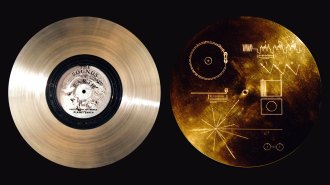Uncategorized
-
 Health & Medicine
Health & MedicineHere’s how lemon juice may fend off kidney stones
Lemon nanoparticles slowed formation of kidney stones in rats. If the sacs work the same way in people, they could help prevent the painful crystals.
By Meghan Rosen -
 Paleontology
PaleontologyThe oldest known pollen-carrying insects lived about 280 million years ago
Pollen stuck to fossils of earwig-like Tillyardembia pushes back the earliest record of potential insect pollinators by about 120 million years.
By Sid Perkins -
 Animals
AnimalsThe fastest claw in the sea belongs to young snapping shrimp
When juveniles snap their claws shut to create imploding bubbles, they create the fastest accelerating underwater movements of any reusable body part.
By Jake Buehler -
 Climate
ClimateAn incendiary form of lightning may surge under climate change
Relatively long-lived lightning strikes are the most likely to spark wildfires and may become more common as the climate warms.
By Nikk Ogasa -
 Health & Medicine
Health & MedicineMedicated eye drops may delay nearsightedness in children
Myopia, or nearsightedness, is a growing global health threat. But a Hong Kong study found that medicated eye drops may delay its onset in children.
-
 Neuroscience
Neuroscience‘Mommy brain’ doesn’t capture how the brain transforms during pregnancy
During the transition to motherhood, there's more going on than “momnesia,” neuroscientists argue. The brain changes to prep for the job of caregiving
-
 Environment
EnvironmentAir pollution made an impression on Monet and other 19th century painters
The impressionist painting style can be partly explained by the reality of rising air pollution from the industrial revolution, an analysis finds.
By Bas den Hond -
 Health & Medicine
Health & MedicineTrauma distorts our sense of time and self. A new therapy might help
The therapy has helped veterans struggling with mental illness imagine their future selves.
By Sujata Gupta -
 Humans
HumansA new biomaterial heals heart attack damage in animals. Humans could be next
If used right after a heart attack, this intravenously delivered biomaterial can preserve cardiac function. It could also treat traumatic brain injury.
-
 Space
Space50 years ago, Earth’s chances of contacting E.T. looked slim
In 1973, a researcher calculated that it could take millions of years to contact aliens. But that hasn’t stopped scientists from trying.
-
 Health & Medicine
Health & MedicineA gel cocktail uses the body’s sugars to ‘grow’ electrodes in living fish
A chemical reaction with the body’s own sugars turned a gel cocktail into a conducting material inside zebrafish brains, hearts and tail fins.
By Simon Makin -
 Astronomy
AstronomyThe Milky Way may be spawning many more stars than astronomers had thought
Glowing radioactive debris from massive stars indicates our galaxy mints 10 to 20 new stars a year — double to quadruple the standard number.
By Ken Croswell